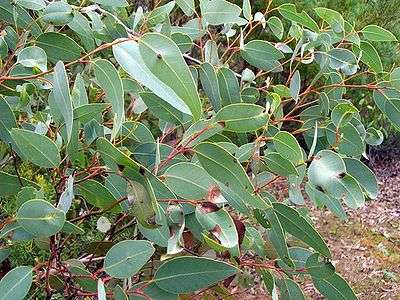Eucalyptus squamosa
| Scaly bark | |
|---|---|
 | |
| trunk and coppice leaves of scaly bark, Glenhaven, Australia | |
| Scientific classification | |
| Kingdom: | Plantae |
| (unranked): | Angiosperms |
| (unranked): | Eudicots |
| (unranked): | Rosids |
| Order: | Myrtales |
| Family: | Myrtaceae |
| Genus: | Eucalyptus |
| Species: | E. squamosa |
| Binomial name | |
| Eucalyptus squamosa Maiden and Deane | |
Eucalyptus squamosa, known as the scaly bark is a seldom noticed eucalyptus tree occurring around Sydney. A small or occasionally medium-sized tree within a very restricted habitat. On and around sandstone plateaus, often on lateritic soils. It grows in dry sclerophyll woodland, where soil accumulates in depressions on the sandstone. Maximum height is around 12 metres.
It can be seen at Royal National Park, Blue Mountains National Park, Ku-ring-gai Chase National Park, Garigal National Park, Lane Cove National Park and other similar reserves, as far north and west as the Putty and Broke districts.
Description
The bark is grey or reddish brown, flaky, somewhat tessellated and fibrous. Bark persists to the upper smaller branches. Care needs to be taken with identification as the red bloodwood's bark is similar. Scaly Bark's juvenile leaves are round or broad lanceolate. Adult leaves lanceolate or occasionally sickle shaped, 7 to 12 cm long, 1 to 1.5 cm wide. A dull grey green on both sides. From a short distance the leaves may appear somewhat bluish.
White flowers form between May to October. The gumnuts are small, 0.5 by 0.6 cm, with usually three exserted valves (sharp wooden points emerging out of the top of the gumnut). Gumnuts and buds may appear disfigured, being warty and wrinkled. Natural regeneration from seed seldom occurs, but the plant tends to recover well after fire by coppicing.
References
- "Eucalyptus squamosa". PlantNET - NSW Flora Online. Retrieved 2010-03-04.
- A Field Guide to Eucalypts - Brooker & Kleinig volume 1, ISBN 0-909605-62-9 page 143
